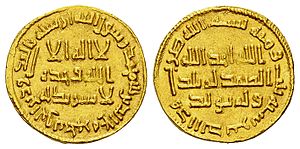
Back يزيد بن عبد الملك Arabic يزيد بن عبد الملك ARZ II Yezid ibn Əbdülməlik Azerbaijani ایکینجی یزید AZB দ্বিতীয় ইয়াজিদ Bengali/Bangla Yazid II Catalan Jazíd II. Czech Yazid 2. Danish Yazid II. German Γιαζίντ Β΄ Greek
| Yazid II يَزِيد ٱبْن عَبْد الْمَلِك | |||||
|---|---|---|---|---|---|
 Gold dinar of Yazid II | |||||
| 9th Caliph of the Umayyad Caliphate | |||||
| Reign | 9 February 720 – 26 January 724 | ||||
| Predecessor | Umar | ||||
| Successor | Hisham | ||||
| Born | c. 690/91 Damascus, Umayyad Caliphate | ||||
| Died | 26 January 724 (aged c. 33–34) (24 Sha'ban 105 AH) Irbid, Umayyad Caliphate | ||||
| Spouse |
| ||||
| Issue | |||||
| |||||
| Dynasty | Umayyad | ||||
| Father | ʿAbd al-Malik | ||||
| Mother | ʿĀtika bint Yazīd | ||||
| Religion | Islam | ||||
Yazid ibn Abd al-Malik ibn Marwan (Arabic: يَزِيد ٱبْن عَبْد الْمَلِك ٱبْن مَرْوَان, romanized: Yazīd ibn ʿAbd al-Malik ibn Marwān; c. 690/91 — 26 January 724), commonly known as Yazid II, was the ninth Umayyad caliph, ruling from 720 until his death in 724. Although he lacked administrative or military experience, he derived prestige from his lineage, being a descendant of both ruling branches of the Umayyad dynasty, the Sufyanids who founded the Umayyad Caliphate in 661 and the Marwanids who succeeded them in 684. He was designated by his half-brother, Caliph Sulayman ibn Abd al-Malik (r. 715–717), as second-in-line to the succession after their cousin Umar (r. 717–720), as a compromise with the sons of Abd al-Malik (r. 685–705).
He reversed the reformist policies of Umar, mainly by reimposing the jizya (poll tax) on the mawali (non-Arab Muslim converts) and resuming the war efforts on the frontiers of the Caliphate, especially against the Khazars in the Caucasus and the Byzantines in Anatolia. Yazid's moves were in line with the desires of the Arab militarist camp and the Umayyad dynasty but did not solve the fiscal crisis of the Caliphate as war booty had become insufficient and the reimposition of the jizya met strong resistance from the converted populations in the large provinces of Khurasan and Ifriqiya. He issued an iconoclastic edict whereby Christian icons were destroyed in churches across the caliphate, influencing the Byzantine emperor Leo III (r. 717–741) to institute a similar edict in his domains.
Yazid reintroduced Syrian troops to enforce Umayyad rule in Iraq, where their domination was long resented. One of the first events of his reign was the wide-scale rebellion of the Iraqis under Yazid ibn al-Muhallab, whose suppression marked the end to the serious anti-Umayyad revolts in the restive province. Ibn al-Muhallab was a champion of the Yamanis and Yazid's appointment of Qaysi partisans to rule Iraq escalated the factional tensions there, though elsewhere Yazid balanced the interests of the two rival factions. The deadly suppression of the Muhallabids became a rallying cry for revenge during the Abbasid Revolution, which toppled the Umayyads in 750.